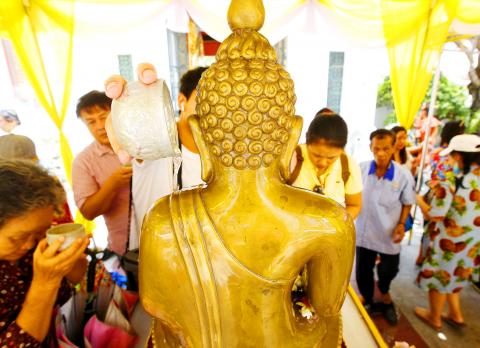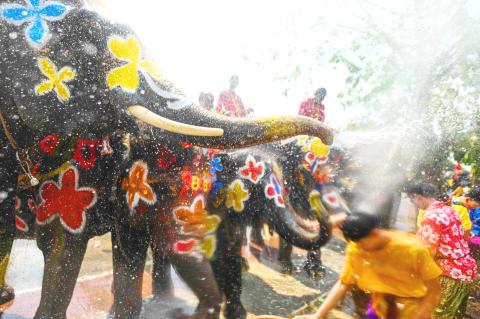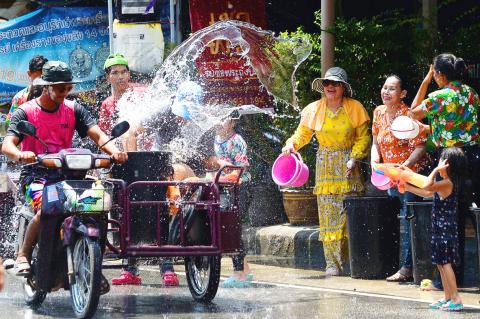Thailand’s traditional New Year, as known as Songkran, is celebrated on April 13 to 15 every year. It is a time when people splash or spray one another with water, to symbolize washing away the old and welcoming the new.
The word Songkran derives from the Sanskrit word for “passage” or “cross over,” representing moving into a new year. Songkran is also celebrated in Myanmar, Cambodia and Laos.
Known by the Taiwanese as the “splashing festival,” Songkran conjures up images of street water fights, with participants using water pistols or buckets. It originated from a traditional Buddhist ritual, and the water represents purification and blessing.

Photo: EPA
照片:歐新社
Songkran is about more than water fights. Traditionally, Thais also go to Buddhist temples to donate money or goods to the temple or monks during the festival, and the monks sprinkle holy water, symbolizing blessings, on them. People also bathe statues of the Buddha by pouring water over them. Thais will also sprinkle water in the hands of family elders, symbolizing respect and the receipt of the elders’ blessings.
Miss Songkran beauty contests are also held throughout Thailand, as a way to preserve traditional Thai costumes.
There are around 700,000 migrant workers in Taiwan. Of these, just over 60,000 are from Thailand.

Photo: AFP
照片:法新社
In order to make Thai workers in Taiwan feel at home, Songkran was celebrated on Sunday at the ASEAN Square in Taichung, organized by the Ministry of Labor and the Taichung government. There will be another Songkran celebration held this coming Sunday at City Hall Square in New Taipei City.
(Translated by Lin Lee-kai, Taipei Times)
每年四月十三日到十五日是泰國的傳統新年(Songkran),又音譯為「宋干節」,其中一個習俗就是民眾相互潑水或噴水,以期除舊布新。

Photo: AFP
照片:法新社
「宋干」一詞來自梵文,有「通過、跨越」的意思,代表進入新的一年。除了泰國,緬甸、柬埔寨和寮國也都會慶祝宋干節。
被台灣人稱為「潑水節」的宋干節,最出名的景象就是大家在街上拿水槍或水桶打水仗。潑水的起源是佛教傳統儀式,因為水代表淨化和祝福。
不過宋干節可不是只有狂潑水而已。泰國人傳統上會在這幾天到佛寺裡奉獻金錢或物品給寺方或僧侶,僧侶們再以聖水灑向民眾,象徵祝福之意,民眾也會以水淋佛像,稱為「浴佛」。此外,泰國人也會把水輕灑在家族長輩手中,象徵尊敬並獲得長輩的祝福。
此外,為了要保存傳統的泰式服飾,泰國各地也會舉辦宋干小姐選美比賽。
在台灣,來台的移工人數已達到七十多萬人,其中來自泰國的移工有六萬人。
為了讓在台灣的泰籍移工一解鄉愁,勞動部與地方政府合作舉辦潑水節活動,十四日已於台中東協廣場舉行,二十一日則將在新北市政府市民廣場舉辦。
(中央社)

A: Which words ranked highest for Google Taiwan’s most searched words of 2024? B: No. 5 to 1 are: “US presidential election,” “Olympics,” “Ko Wen-je,” “typhoon” and “earthquake.” A: I heard that Google also released a list of most searched word meanings. B: Yeah, the most popular searches included “M3,” “APT” and “release without bail.” A: Let me google their meanings now. A: Google 2024 台灣搜尋排行榜,前幾名是什麼? B: 第5至1名是︰「美國總統大選」、「奧運」、「柯文哲」、「颱風」、「地震」! A: 我聽說Google還有一個搜尋字義的排行榜。 B: 對啊前幾名是︰「M3」、「APT」、「無保請回」。 A: 讓我搜尋一下他們是什麼意思。 (By Eddy Chang, Taipei Times/台北時報張聖恩)

Stonefish may not be the most impressive-looking animal in the sea. In fact, this fish is so skilled at camouflage that most people wouldn’t notice it if they swam past it. Despite their unremarkable appearance, stonefish are the most venomous fish in the ocean. Stonefish come in various shades of brown, red, yellow, and orange. Their rough skin texture and blotchy color pattern give them a remarkable resemblance to stones, which is where their name comes from. This feature helps them blend in with their surroundings exceptionally well. Stonefish are notable for their 13 highly venomous spines which protrude

Renhe sat stiffly at the Wei Ya banquet, picking at the symbolic dishes on the table. Fish for abundance, sticky rice cake for progress — it all seemed superstitious to him. The shrine to the Land God near the entrance, adorned with offerings, incense, and fruit, struck him as frivolous. “What does this have to do with running a business?” Renhe scrolled on his phone as his co-workers performed skits and poorly sung songs. He wasn’t even paying attention to the lucky draws when his name was called. The room filled with applause and cheers as he went to the stage

「雙手合十/合掌禮」(namaste) or 「碰肘/擊肘」 (elbow bump): 新冠肺炎流行逐漸改變現代社會的某些社交禮儀,歐美許多名人政要開始以「雙手合十/合掌禮」(namaste) 或「碰肘/擊肘」(elbow bump) 替代握手。 《今日商業》報導英國王儲查爾斯以「雙手合十」代替握手。 Coronavirus update: Prince Charles spotted greeting people with namaste (Business Today , March 12, 2020) 另外,《商業內幕》報導:疫情期間美國總統川普在白宮舉行新冠肺炎記者會,想和居家照護公司LHC集團執行副總葛林斯坦 (Bruce Greenstein) 握手,葛林斯坦婉拒,示意改用擊肘。 President Donald Trump attempted to shake hands with a home health care company executive . . . but the man turned the president down and offered him an elbow bump instead. (Eliza Relman, Business Insider , March 14, 2020) 「雙手合十/合掌禮」源自印度,也流行於泰、緬等國家。「碰肘/擊肘」則是 2006 禽流感、2009 豬流感後逐漸流行。疫情逐漸改變我們的生活方式,包括打招呼等社交禮儀,也出現了微妙的變化。 「拱手禮」(fist-and-palm salute) 至於華人社會傳統上也有雙手互握合於胸前「拱手禮」(fist-and-palm salute)。公益網站 Just Quarantine 提到: Taiwanese president Tsai Ing-wen demonstrating social distancing through use of a traditional Chinese greeting (fist & palm) instead of shaking hands in response to the COVID-19 pandemic. 因應新冠肺炎疫情,2020 當年總統蔡英文與來訪賓客保持安全距離,拱手 (fist &